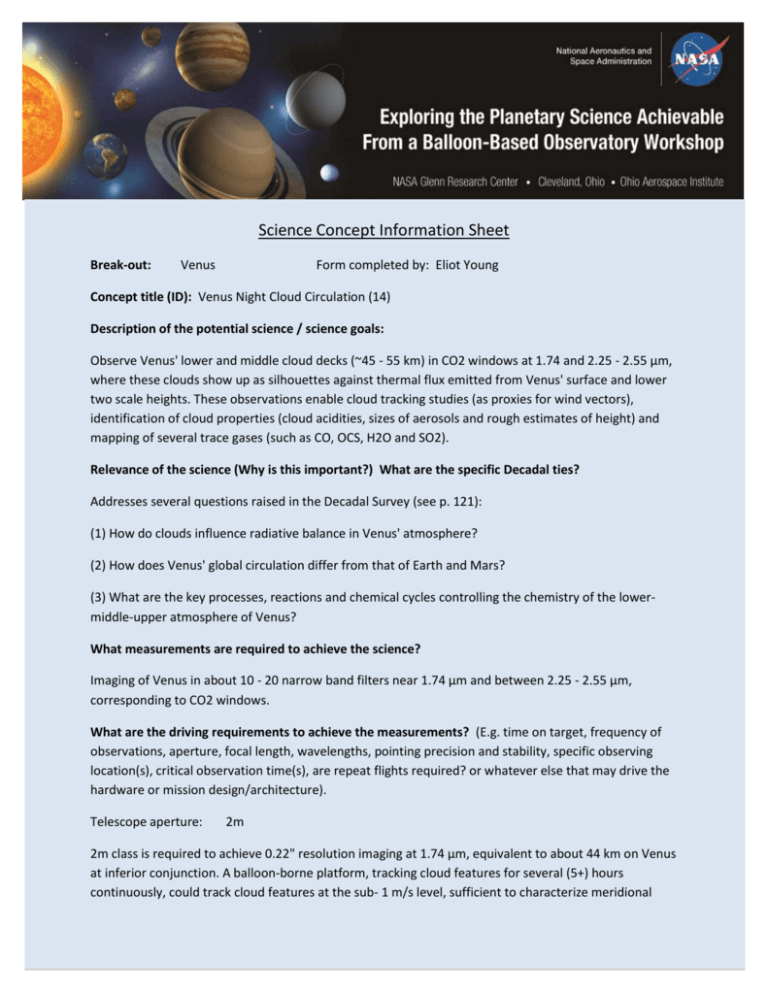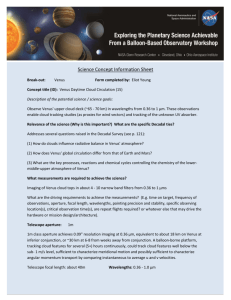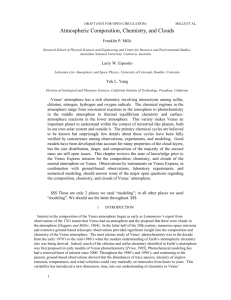Venus clouds circulation (night)
advertisement

Science Concept Information Sheet Break-out: Venus Form completed by: Eliot Young Concept title (ID): Venus Night Cloud Circulation (14) Description of the potential science / science goals: Observe Venus' lower and middle cloud decks (~45 - 55 km) in CO2 windows at 1.74 and 2.25 - 2.55 µm, where these clouds show up as silhouettes against thermal flux emitted from Venus' surface and lower two scale heights. These observations enable cloud tracking studies (as proxies for wind vectors), identification of cloud properties (cloud acidities, sizes of aerosols and rough estimates of height) and mapping of several trace gases (such as CO, OCS, H2O and SO2). Relevance of the science (Why is this important?) What are the specific Decadal ties? Addresses several questions raised in the Decadal Survey (see p. 121): (1) How do clouds influence radiative balance in Venus' atmosphere? (2) How does Venus' global circulation differ from that of Earth and Mars? (3) What are the key processes, reactions and chemical cycles controlling the chemistry of the lowermiddle-upper atmosphere of Venus? What measurements are required to achieve the science? Imaging of Venus in about 10 - 20 narrow band filters near 1.74 µm and between 2.25 - 2.55 µm, corresponding to CO2 windows. What are the driving requirements to achieve the measurements? (E.g. time on target, frequency of observations, aperture, focal length, wavelengths, pointing precision and stability, specific observing location(s), critical observation time(s), are repeat flights required? or whatever else that may drive the hardware or mission design/architecture). Telescope aperture: 2m 2m class is required to achieve 0.22" resolution imaging at 1.74 µm, equivalent to about 44 km on Venus at inferior conjunction. A balloon-borne platform, tracking cloud features for several (5+) hours continuously, could track cloud features at the sub- 1 m/s level, sufficient to characterize meridional motion and possibly sufficient to characterize angular momentum transport by comparing instantaneous to average u and v velocities. Telescope focal length: about 40m Wavelengths: 1.74 - 2.55 µm Pointing precision: 0.1". Required time on target: 20 -40 days. Images in all filters can be obtained in tens of minutes, but a baseline of several hours is necessary to get reliable cloud motion rates. Total mission durations of 20 to 40 days (centered on inferior conjunction) are necessary to look for planetary wave phenomena that are predicted in GCMs. Are there other ways to achieve this science, and if so, why would a balloon platform be preferable? The JAXA/VCO mission would have provided images of Venus at 1.74, 2.30 and 2.32 µm that would have provided excellent cloud tracking and CO mapping data sets, but VCO did not enter orbit around Venus. Venus Express VIRTIR IR image cubes (no longer obtainable) provided repeated cloud tracking rates of the southern hemisphere at the 5 m/s level. IRTF observations provided rates of the N and S hemispheres at the 3.5 m/s level in the best seeing conditions. A balloon mission is necessary for three reasons: (1) long, uninterrupted observing baselines of several hours are essential to determine cloud motions at the 1 m/s level and better, (2) a mission duration of 20 - 40 continuous days is necessary to characterize planetary wave phenomena, and (3) certain wavelengths are opaque at the Earth's surface (e.g., 2.53 µm, important for establishing cloud altitudes, is difficult to observe from ground-based telescopes). What are the potential observation targets? Venus during inferior conjunction. What planetary science disciplines would this involve? Planetary Geology, Planetary Atmospheres, Comparative Planetology Point of contact for follow-on questions (Name and contact info) Eliot Young (efy@boulder.swri.edu, 720-432-2333)









